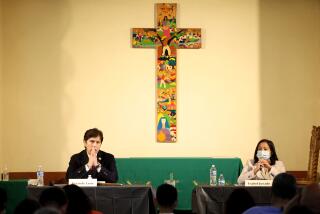City Weighs Reply to Voting System Suit
With one councilman already planning a legal defense fund, Santa Paula officials appeared Friday to be gearing up to fight a U.S. Department of Justice lawsuit aimed at increasing the number of Latino council members.
John E. McDermott, a lawyer hired to advise the city, said next week he would recommend challenging the Justice Department in court rather than agreeing to the federal government’s demand that the city’s at-large election system be changed to one in which leaders are elected from five districts.
The council is scheduled to meet privately with the lawyer Monday night to discuss legal strategy.
McDermott contends that citywide, Santa Paula has proportionately as many Latino voters as a Los Angeles County supervisorial district that was created by Justice Department litigation to increase representation of Latinos. That fact alone, he said, should make the federal government’s case so weak that it would be rejected by a judge within six months to a year.
Four of five council members have said they oppose efforts to carve the city into five pieces in order to create two primarily Latino voting districts.
The city argues that district elections tend to create turf wars over limited municipal dollars and contend that the district system is inefficient for small cities. They are also digging in on philosophical grounds, saying to comply with the federal government’s demands now would be tantamount to admitting the city is running a racist system.
Mayor Richard Cook and Councilman Jim Garfield said Friday that they plan to vote to proceed with the litigation. Councilman Don Johnson said he opposes the Justice Department’s plans but wants to know more about the city’s financial position before committing to a fight. Councilwoman Robin Sullivan, a candidate for the state Legislature, has consistently opposed the Justice Department’s efforts, but on Friday she declined to comment.
Councilwoman Laura Flores Espinosa, the sole Latino on the council and an advocate of the district system, is the only council member calling for a conversion.
Meanwhile, the city is seeking a written opinion from its insurer, the Central Coast Cities Self Insurance Fund, on whether its $10-million liability policy would cover such litigation. Municipal insurers once covered those costs but changes to the law in recent years make the insurer’s obligation unclear, said Assistant City Manager Julie Hernandez.
McDermott estimated that defending Santa Paula’s at-large system could cost between $100,000 and $1 million.
That’s considerably less than voting rights cases in the city of Santa Maria, where the tab for a 7-year-old case has reached $2 million, or in Los Angeles County, where a case in the late 1980s hit $6 million, McDermott said.
Nevertheless, it’s a potentially staggering tab for a city of 27,000 residents with about $1 million in reserves.
Garfield said Friday he is talking with some city residents about creating a private legal defense fund to assist the city’s efforts. It was unclear how the law would govern the use of such a fund. City Atty. Phillip H. Romney could not be reached for comment.
McDermott also has been in touch with the conservative Sacramento-based Pacific Legal Foundation. A spokesman for the group, which has also taken positions on education and property rights in California, said it was “quite interested” in joining in the city’s defense.
McDermott said the Justice Department has not provided sufficient evidence of a violation of the Voting Rights Act of 1965, the law it claims Santa Paula’s election system violates.
The suit seeks to carve the 4.5-square-mile city into five voting districts, two of which would be overwhelmingly comprised of Latinos. City officials point out, however, that in recent years the city has elected two Latinos simultaneously to the council without federal intervention.
But federal officials say that is not good enough. District elections would guarantee that the political will in heavily Latino neighborhoods would not be thwarted by white voters, who historically have voted in blocs to defeat candidates preferred by Latinos.
Jesse Ornelas, a low-income housing builder who supports the Justice Department’s lawsuit, said the city should agree to district elections.
“The majority of the taxpayers in town are Latino,” he said. “They’re using Latino money to defend a system that has historically kept Latinos from economic power, political power and social status. They’re using Latino money against Latinos.”
But John Findley of the Pacific Legal Foundation said that in Santa Paula, where many Latinos and whites have married and raised blended families over the past century, the underlying arguments in the Justice Department’s case can be disputed.
Councilwoman Sullivan is one-fourth Latino. Findley argued that makes her Latino, regardless of the fact that she is a light-skinned, well-to-do real estate lawyer who was not a preferred candidate of Latino voters.
“How do you decide who is a Latino or who isn’t?” Findley asked. “Does it have to be 51% ethnicity? Why the Justice Department is doing this is beyond me.”
More to Read
Sign up for Essential California
The most important California stories and recommendations in your inbox every morning.
You may occasionally receive promotional content from the Los Angeles Times.









